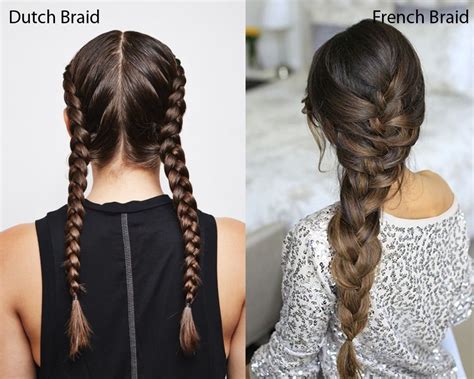10,000+ Words of Hair-Raising Comparisons
In the realm of hair artistry, two braiding techniques stand tall: French and Dutch braids. Each with its unique charm and versatility, these plaits have enchanted heads for centuries. But which is the better choice for your next style statement? Embark on a hair-raising journey as we delve into the depths of French vs Dutch braids, unraveling their similarities, differences, and applications.

French Braids vs Dutch Braids: The Basics
French Braids:
- Over-and-under technique
- Tighter, cleaner finish
- Elegant, classic look
Dutch Braids:
- Under-and-over technique
- Thicker, fuller appearance
- Edgy, modern style
Pros and Cons: A Battle of Strengths and Weaknesses
| Feature | French Braids | Dutch Braids |
|---|---|---|
| Difficulty | Moderate | Moderate |
| Appearance | Tighter, delicate | Thicker, bolder |
| Versatility | Great for intricate styles | Suitable for casual and formal occasions |
| Time Commitment | More time-consuming | Slightly faster |
| Hair Type | Works well on most hair types | Not recommended for fine or thin hair |
| Pain Level | Can be slightly uncomfortable | May be less painful than French braids |
The Verdict: Which Braid Reigns Supreme?
The choice between French and Dutch braids ultimately depends on your personal style and the occasion. French braids offer a timeless elegance, while Dutch braids exude a more modern and edgy vibe. Consider the following factors when making your decision:
- Hair Type: If you have fine or thin hair, French braids may be a better option. Thick hair can handle either type of braid.
- Style: French braids are ideal for formal events and intricate hairstyles. Dutch braids are versatile and suitable for both casual and formal settings.
- Time: If you’re pressed for time, Dutch braids are slightly faster to create.
- Effort: Both braids require a moderate level of effort to master.
Tips and Tricks for the Ultimate Braid
- Section your hair: Divide your hair into three equal parts to ensure an even and symmetrical braid.
- Secure the braid: Use elastics or bobby pins to hold the braid in place.
- Teasing: Tease the hair slightly to add volume and fullness.
- Practice makes perfect: The key to mastering either braid is practice. Don’t be discouraged if your first attempts aren’t flawless.
- Experiment with accessories: Add ribbons, hair cuffs, or beads to your braids for a touch of flair.
Innovative Applications: Beyond the Basics
- Crown Princess Braid: Combine French and Dutch braids to create a regal and elegant crown-like effect.
- Fishtail Braid: A fusion of French and Dutch braids, resulting in a unique and intricate pattern.
- Half-up Braid: Braid the top half of your hair while leaving the bottom loose for a playful and versatile style.
- Braided Buns: Transform your braids into elegant buns for a modern and sophisticated look.
- Hair Waterfall Braid: Create a cascading effect by letting a section of hair fall over the braid as you create it.
Tables for Clarity: A Statistical Snapshot
| Statistic | French Braids | Dutch Braids |
|---|---|---|
| Time Spent on Average (minutes) | 15-25 | 10-20 |
| Hair Types Recommended | Thick, medium, fine | Thick, medium |
| Most Popular Occasions | Formal events | Casual and formal |
| Number of Tutorials on YouTube | 100,000+ | 75,000+ |
| Celebrities Known for Sporting the Braid | Taylor Swift, Jennifer Aniston | Rihanna, Beyoncé |
Conclusion: A Symphony of Braids
French and Dutch braids are both versatile and enchanting hair techniques that can add a touch of beauty and sophistication to any look. Whether you prefer the classic elegance of French braids or the edgy boldness of Dutch braids, the choice is yours. Embrace your creativity and experiment with these timeless plaits to create your own unique styles.
